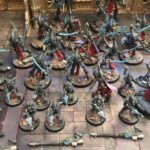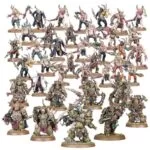How to get into Warhammer 40k tabletop
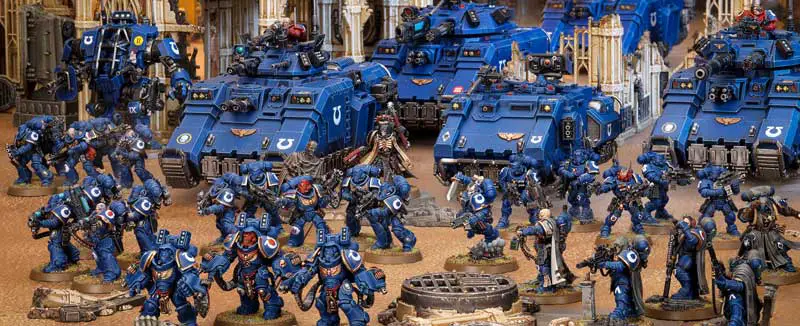
The world of wargaming has many fun games. However, Warhammer 40k stays the most popular of the bunch. Its general tone and cool models enticed millions of players to try it out. Getting into it can seem a lot more harrowing, especially with the seemingly impenetrable rules.
Of course, the outsider perspective can be deceiving. Learning the game doesn’t take that long if you have the right tools and knowledge. Getting into the game becomes far easier when everything is quickly available.
the best way to start with 40k tabletop game
Aside from reading rules and codices, the best way to learn is through play. Finding another newbie for a practice match is a great way to fill in any gaps in knowledge, while also providing them corrections for any rules too.
Check if any of your friends are interested in the game or look for other newbies. Playing with people of similar skill level is the best way to learn and have fun at the same time.
Of course, concerns of the hobby’s price can dissuade some. Worry not, you needn’t get those players to buy all of the pricey plastic. Tabletop Simulator will work just fine, having a lot of built-in functionality.
Overview of the tabletop game and a brief history
Warhammer 40k received its first game back in 1987, titled Warhammer: Rogue Trader. It was based on the 1980 game, Laserburn. The rules and setting were written by Rick Priestley but would get expanded by many writers as time goes on.
The game has gone through 9 editions since. With every new edition bringing in new units, rules, and even entire factions. We are currently in the 9th edition, which is still receiving proper updates that aim to convert everything from the 8th.
Suffice to say, we will be in this edition for a little while longer.
The game features a rich lore that has been expanded upon over the years through various novels, comics, and other media. The lore explores the intricate political, religious, and military systems of the different factions and their struggles for dominance in the galaxy.
Among the different factions we can mention the Imperium of Man, the Adeptus Mechanicus, the Space Marines, the Chaos Space Marines, the Eldar, the Orks, the Tau, the Necrons, the Tyranids, and more.
Can a beginner find his way around the game?
Yes, beginners can figure out the game rather fast. The procedures and numbers may seem overwhelming at first but the flow of the game is quickly learned. Learning how to quickly reference specific rules is the key skill to learn.
What you need to get started with Warhammer tabletop?
Of course, before we start playing, we will need a couple of things. Aside from another player to test your mettle against.
Here are a few things to consider:
Do you need miniatures?
Yes, miniatures represent your units and indicate where each is located. The more units there are the more important miniatures become for keeping track of things. Miniatures are the most important part of the game so having them on hand is key.
Of course, if you don’t have the money to buy all the miniatures needed or any at all, there are always alternatives. It can be anything that has the same radius as the miniature’s base. This base can also be made easier to read by printing out 2D miniatures which can be attached to any base.
A Beginner’s Checklist for Warhammer Tabletop Gaming
Table
You will need a table of four by six feet in dimensions. Usually, dining tables will be enough to accommodate the game with little issue. Without a table there’s no game, so find the place that you feel fits best for the game.
Miniatures
If you have a small army with a low model count, you can manage with just 20-30 miniatures. However, having a larger collection of around 100 miniatures can be beneficial, even if it’s not strictly necessary. This will give you more flexibility in terms of army composition and allow you to try out different strategies and tactics on the tabletop.
The Rulebook
The Warhammer rulebook is a comprehensive guide that contains all the rules you need to play the game. It covers everything from how to set up the game, to how to move your miniatures, to how to attack and defend against your opponents.
*You can get a free, basic, rulebook here (English version).
The Codex
A Codex includes army lists, which outline the specific units that are available to your army, as well as their points costs, abilities, and equipment options. It also includes detailed background information on the history and culture of your chosen faction, which can help you to better understand and role-play your army.
Dice
The whole game uses six-sided dice. Make sure each player has a lot of them on hand. If needed, you can roll the same dice again to decide all the necessary actions but make sure to write down the results beforehand.
Terrain
Some terrain is also desired. This can be proper, official terrain, or just about anything in your home. The rules in the game do not specifically dictate anything except the effects that can be determined with the naked eye. Get some remotes, rocks, or whatever else as terrain.
Measuring Tape
A couple of rulers are required. You will need these to measure distances for all sorts of actions. It’s recommended to get both shorter and longer ones, for easier measurements across the board.
Pen and Paper
Lastly, you’ll need some paper. Writing down command points, victory points, special army abilities, or even strategizing can benefit from it. This goes double if your game uses secondary objectives.
Virtual alternative
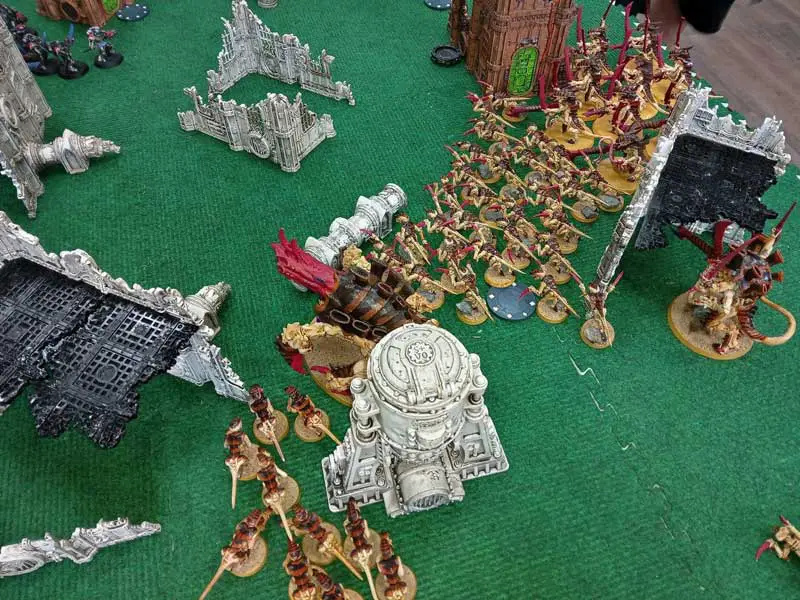

Considering all of that prep and potential cost, some people could be deterred from even trying the game. Especially considering how much an entire army can cost. Don’t worry though, there is a cheaper alternative.
Tabletop Simulator is a great tool for wargaming, board games, and TTRPGs. The Steam workshop mods contain most if not all assets for free. That includes armies, maps, and even some basic rules.
Tabletop Simulator itself may take a bit to learn but it’s worth the investment. At a 20-dollar price tag, it’s rather cheap. Especially when you take into account how often it goes on sale.
How to assemble an army
To play, you and your opponent will need to assemble an army each. The size of the armies depends on the number of points you choose to play with.
You can make an army that has a point cost equal to or lower than the size the players decide on.
For your first game, it’s suggested to start with point costs between 500 and 1,000.
The army itself needs to be composed out of detachments. The amount of detachments available is also determined by game size, of which the smallest one is Combat Patrol. Combat patrol allows only one detachment to be inserted.
What Warhammer army should you start with?
Necrons and Space Marines are two of the best starting armies to choose between. Both have powerful armor, decent shooting skills, do fine in melee if needed, and don’t require complex tactics to do well.
Both armies are decently forgiving even if you don’t play them to their fullest extent. Which makes them great for beginners. Whiffing a maneuver won’t be as punishing as with certain other armies.
Necrons and Space Marines both possess generally simple abilities, allowing you to immediately understand their game plan. Their armies can easily be filled with powerful arsenals that will allow players to deal with any threat.
Sometimes, a unit can easily take care of two roles due to the flexibility present.
The versatility of both armies allows us to change up choices as we learn. What starts off as a simple army can be adjusted later for a more complex one.
Playing Warhammer 40k tabletop
A game of Warhammer 40k is played with two players over multiple hours. The hardest part of the entire experience can be the act of finding a new player, as the time-intensive nature of the game isn’t for everybody. Online forums and communities can provide a great place to find other players to play the game with too.
Can you play alone?
Only if you are playing on Tabletop Simulator. This virtual tabletop has a workshop that allows you to automate deployment and rounds for AI. While you’ll still have to do certain stuff yourself, this helps quite a bit to facilitate solo play.
Is it hard to play?
While strategies and tactics in Warhammer 40k can run quite deep, the general rules are easy to understand. If the official sources don’t feel clear, there are a ton of resources that explain them in their own way.
There are a few pages of them though, so having a rules reference document can help during the first few games. Just about anything you’ll need is found in those.
What is the codex, how to use it, and does a beginner need it?
Each army in the game has a Codex. Codex is a rules supplement that has all the necessary information about the army. Environments and Worldwide campaigns can also have their own codices but army ones are the most important ones.
Inside of a Codex, there will be quite a few things to get through. First and foremost are units and wargear. The stats and abilities of those two are most used when it comes to playing a faction. On top of that, you can find army-wide abilities, stratagems, and some lore.
The best way to use a Codex is by noting frequently used rules and abilities from it. This way, we will slowly make our own reference supplement to refer to whenever an ability comes into play. Of course, having all of the stats from your units on hand is immensely useful so keep a codex close.
It’s recommended that you get a codex of the army you want to play.
Going through this book can be a great way to learn some of the nuances of that faction. Reading the entries usually helps players remember more of them too. However, if those aren’t available to you, there are plentiful online tools to use for army building and rule references.
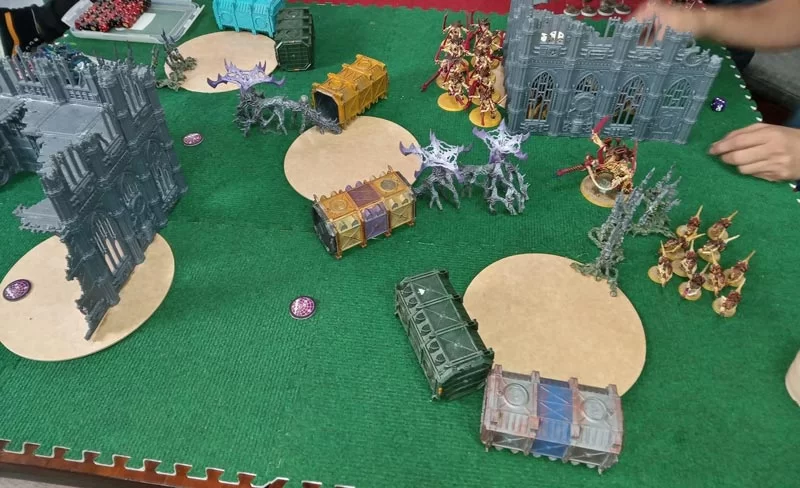

How to Play Warhammer 40k Tabletop (Explained for Beginners)
That’s enough preparation. How do you play the game? Well, we’ll give a quick rundown of what an average game of Warhammer 40k is made out of. Additionally, Warhammer 40k’s most important core rules will be covered.
Understanding the rules and mechanics
To help you better understand the following part, let’s go over some of the basic rules and mechanics. These are far from a complete guide to general rules but they should give you a rough idea of the game.
Rules:
- Every action in the game is decided by rolling six-sided dice. This goes for any phase of the game, although the numbers you’ll be referencing change.
- To succeed, you need to roll higher than the stat, found on the model’s datasheet. The stats of the datasheet include Movement, Weapon Skill, Ballistic Skill, Strength, Toughness, Wounds, Attacks, Leadership, and Save.
- To deal damage to an enemy, you need to succeed on both hitting and wounding the target. Hitting is gauged by your Ballistic Skill or Weapon Skill depending on the phase.
Wounding is done by comparing the weapon’s Strength to the target’s toughness. After that, they get to roll a saving throw based on their Save. If they fail the wound goes through.
- The army is composed of units, which are made out of models. A squad of Space Marines is a unit while each Space Marine in the squad is a model.
Models in a unit have to stay within six inches of each other. Breaking that means they lose coherency and need to regroup before doing anything else.
Mechanics:
- Stratagems are special abilities of the army, they have conditions when they can be used. Each army has its own list of stratagems, learning how to use them is key for better efficiency of your troops.
- Command Points are special points that can be used to trigger stratagems, you start with a few and generate more as the game goes on. Command Points can also be spent to reroll one die each turn.
- Abilities are special rules that help or hinder the army. They could be completely passive or have triggers. Unit’s abilities are the most impactful part of the game’s diversity, as well as the most important part to learn for every faction.
Step-by-step instructions for playing the game
Every game of Warhammer 40k is composed of phases, turns, and rounds. Each phase is used for different actions, which move the game state forward.
During a round, each player will get a turn to act. On their turn, players take the following phases, in order. After both have finished their turns, the round ends and a new one begins, with the person who took the first turn going again.
- Command phase
The only phase the players share. During this phase, each player gets a Command Point.
Certain abilities, missions, and rules specify that they trigger or need to be triggered during the command phase. Keep an eye out for that.
- Move phase
Very straightforward, movement phase is the one during which units position themselves on the map. It’s a strategically important phase so take your time during it.
During the movement phase, units can also choose to advance, which allows them to move an extra distance equal to a roll on a six-sided die. Doing so gives them a -1 penalty to attack rolls unless otherwise specified.
- Psychic phase
this is the phase during which units that have psyker on their datasheet can use their abilities. Psykers are psychic mages in the Warhammer 40k universe and their spells vary from damaging the enemy to supporting the allies.
Manifesting a psychic power calls for a Psychic Test. This test is done by rolling 2d6, if you roll over the required number for the spell, it goes off. If you don’t, the spell fails. Rolling two ones inflicts perils of the warp, which may kill your model.
- Shooting phase
usually the most impactful phase. You go unit by unit and shoot all of their weapons at targets within range. Once the player is done shooting, it’s time for the charging phase.
The result of unit shooting was explained above. You resolve all three steps (hitting, wounding, saving) immediately when a unit shoots another and then move onto the next action.
- Charging phase
During this phase, units can charge. Charging allows units to enter the melee range if their charge is successful.
When charging, the unit rolls a 2d6. If the result is higher than the distance between them and the target, the charge succeeds. After the charge, units can move into melee range, ready for the fighting phase.
- Fighting phase
Usually, the bloodiest, fighting phase includes all sorts of close-quarters combat. The reason behind it is simple, both units engaged in melee combat can make their attacks. This means more chances for models to be lost on both sides.
The rules for it are the same as the shooting phase, except with Weapon Skill being referenced. Once in melee, targets can’t shoot and must use an action during the movement phase to disengage.
- Morale phase
This is where all the losses come into play. Lost models within a unit should be tracked for this specific phase. Each unit that lost models makes a morale test. If the player’s units pass their morale test, nothing happens. If they fail, more models are removed.
Tips for Beginner Players
To top off all the directions given above, here are some quick tips. It’s good to memorize these early and then build onto them with the fresh knowledge you acquire.
Strategies for success
- Focus on objectives, not kills (unless the two coincide)
- Stay in cover as often as possible.
- Make full use of your long-range weapons
Common mistakes to avoid
- Don’t make your army samey in firepower, make sure to have tools for all occasions
- Don’t be afraid to lose units if it could benefit you
- Don’t give up, losing can teach you a lot
- Don’t feel obliged to stick to an army, try new ones out
Additional Resources for Warhammer 40k Tabletop
There are a ton of other resources you can use to make the experience of playing this game even better. Here are a few of the best to try out.
Recommended books and online resources
- Army Codex
- Army Index
- Wahapedia
- Goonhammer
- BattleScribe
- Auspex Tactics
Communities and forums for players
- The Official Warhammer 40k Forums
- Heresy Online Forums
- Dakka Dakka Forums
- Warhammer 40k Reddit
Conclusion
Warhammer 40k can seem difficult to get into. However, learning the basics of the game isn’t that hard. Most of the rules are straightforward enough to get the hang of after one or two readings.
Of course, having a variety of resources on hand is the best way to ease your way into the game. Explore the ones noted in here and use those that fit your needs best. It could make your experience much easier.
Sources:
https://www.wargamer.com/warhammer-40k/detachments
https://www.goonhammer.com/getting-started-necrons/
https://www.40krpgtools.com/resources/forums-communities/

